
Universal, 12 Chapters, 1940. Starring Larry “Buster” Crabbe, Carol Hughes, Frank Shannon, Charles Middleton, Don Rowan, Lee Powell, Anne Gwynne, Roland Drew, Donald Curtis, Shirley Deane, Victor Zimmerman.
To the accompaniment of a flash of lightning and the thundering strains of Franz Liszt’s “Les Preludes,” we’re off again on another amazing Flash Gordon adventure. Once again, our Earth is in deadly peril, this time from a mysterious and lethal plague known as the Purple Death. And, as in the case of the onrushing planet of peril in the first serial and the Nitron Beam in the second serial, no one is able to stop the threat but Flash Gordon (Larry “Buster” Crabbe) and Dr. Zarkov (Frank Shannon). Zarkov and Flash, along with Dale Arden (Carol Hughes) discover that a spaceship from another planet has been dropping the dust that causes the Purple Death plague into the Earth’s atmosphere. That ship is from Mongo, and is spreading the plague at the command of the Emperor Ming (Charles Middleton)–reports of whose death have been greatly exaggerated. The Emperor has returned to his old palace on Mongo and is plotting to wipe out life on Earth and on any other planet that resists his planned conquest of the entire universe. Our heroes once more rocket to Mongo to battle with Ming, joining forces with rightful ruler Prince Barin (Roland Drew) to combat Ming’s horrible arsenal of deadly weapons, as the fate of the Earth and the universe hangs in the balance.
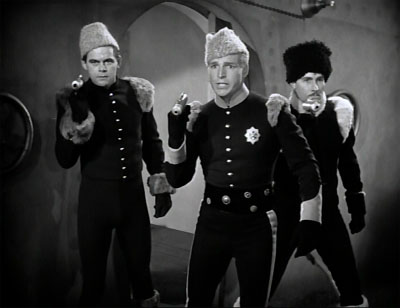
Above: Flash, flanked by Turan (Edgar Edwards, left) and Roka (Lee Powell, right) crashes into Ming’s lab to stop a Purple Death test.
Flash Gordon Conquers the Universe has often been unfairly branded as the weakest of the Flash Gordon trilogy, and sometimes even dismissed as an out-and-out failure. Part of this unwarranted negativity stems from the serial’s casting of new actors in the roles of Dale Arden, Prince Barin, and Princess Aura; it’s also traceable, however, to a myth set in motion by Jim Harmon and Donald F. Glut’s book The Great Movie Serials. Glut and Harmon inaccurately gave the impression that Universe was low-budgeted, largely took place in a frozen area of Mongo called Frigia, and overrelied on stock footage from the German film White Hell of Pitz Palu. This is quite simply untrue; only two of Universe’s chapters are set in Frigia, and the German stock is used very sparingly, being intercut with plenty of original footage of the serial’s stars. Despite its often lukewarm reviews, misleading or otherwise, Conquers the Universe can easily stand comparison to the other serials in the Flash Gordon trilogy; it might fail to match them in some areas, but it surpasses them in others.
Universe, though not as expensively-produced as the first Flash Gordon serial, was obviously made on a lavish budget by serial standards, the Frigia Myth notwithstanding. Though no less visually interesting, the costumes this time out are somewhat different than in the earlier serials; Universal in this serial was attempting to catch up to the artistic alterations in Alex Raymond’s strip that had taken place over the years; thus, we have the good guys wearing Robin Hood-like forester outfits a good deal of the time, which had been featured in the strip as the national costumes of Prince Barin’s wooded realm of Arboria since 1935. Ming’s soldiers, again echoing the strip, also have a different look–being dressed in Ruritanian-style uniforms rather than clanking armor.
In the set department, the enormous throne room used in both serials is back, as are the winding palace hallways used in Trip to Mars, although the rooms opening off the halls are fitted with differently-designed doors, which prevents them from looking like a mere rehash of Azura’s palace rooms in the earlier serial. The barren, rocky portions of Mongo (called the Land of the Dead, as we learn for the first time in this serial), only briefly glimpsed in Flash Gordon, serve as the backdrop for a good deal more of the action in this outing, with some interesting chases over their mountains and rocky trails (portrayed by the Red Rock Canyon area). Between the Land of the Dead scenes and the Frigia sequences, the serial manages to avoid too much visual duplication of the first Flash serial’s palace scenes and the second one’s forest sequences.
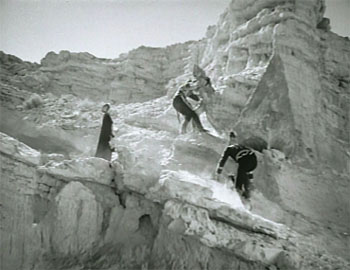
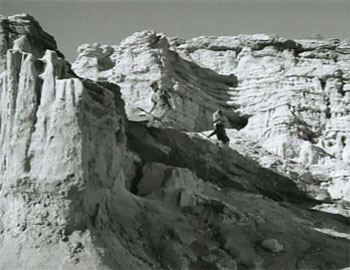
Above: Ming’s followers fight a Rock Man at left, while Flash and Roka hurry up to join the fray at right, against the backdrop of the “Land of the Dead.”
The “televiewers” of the second serial are back on board in this cliffhanger–as are the spaceship miniatures of the first serial; this time out, the interior spaceship sets are designed on a more intricate scale, with complicated control boards, communication devices, and bombing equipment–all of which makes the ships’ operation seem a bit more plausible, if still quite impossible. Ming’s laboratory, rather than being the single and slightly barren room that serves so many serial mad scientists, is so full of sinister compartments and gadgets–the cabinets in which he tests his Purple Death dust on his victims, the chamber where he assembles his fire missiles–that universal conquest seems more feasible for him than for most chapterplay villains.
As in the earlier Flash serials, there are plenty of colorful minor touches that help to give the world of Mongo a distinctive look and feel–examples being the excellent camouflage costumes of the Rock People and their undecipherable language (merely English-language dialogue played in reverse, but it works well), the horned horses ridden by Aura and her entourage, and the oddly plumed bird used by Ming’s spy Sonja (Anne Gwynne) to carry messages (a crow with a topknot of white feathers).
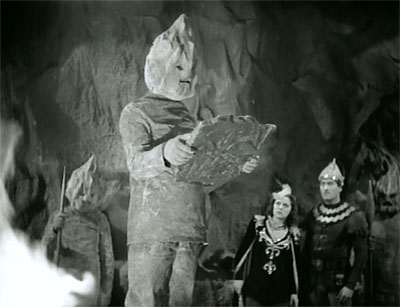
Above: One of the Rock Men passes sentence on Dale and Roka.
One area in which Universe surpasses Flash Gordon and equals if not surpasses Trip to Mars is in the pacing department; one action sequence follows another with real rapidity. There’s an elaborate fistfight in Ming’s dungeons in the first chapter, with Flash, Zarkov, and some of Barin’s officers taking on Ming’s men and Flash falling into a pit full of poisonous Purple Death vapor, several rocket chases and dogfights, a sequence in which Flash and Roka (Lee Powell) dodge rolling stones along a narrow trail while trying to rush Ming’s henchmen, and a very good fight between Flash and Dale on one side and Torch (Don Rowan) and Sonja atop one of the towers of Barin’s palace.
Another action highlight is a very eerie sequence in which Flash and his party, mining “polarite” in Frigia, are attacked by Ming’s “Annihilatons,” robots that either electrocute their opponents or destroy them by exploding themselves. The Annihilatons are merely men in robot costumes, but they are filmed at a jerkily undercranked speed that gives them an eerily inhuman demeanor; their attack is so creepily inexorable and devastating that even Flash and Zarkov seem to get a bit rattled.
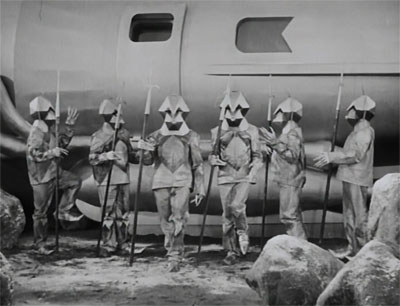
Above: The Annihilatons on the march.
The Annihilaton sequence leads into a memorable chapter-ending cliffhangers; another memorable cliffhanger is the triple one that has Flash falling from a cliff, Dale about to be thrown into a fire pit by the Rock People, and Zarkov being attacked by an “Iguanatheon” (one of the enlarged lizards also used in the first Flash serial). Yet another memorable chapter ending has Flash, Zarkov, Barin, and Roka trapped in a flood in the tunnels beneath Ming’s palace; the real standout for me, though, is the Chapter Four ending, simply because of the way it illustrates all the recurring characters’ relationships and personalities. Zarkov is made a prisoner of Ming and, after refusing to abet his plans, is shackled in the path of a death ray. Flash heroically leaps through a window to save him, coming into the path of the ray and ignoring the no-less-heroic Zarkov’s pleas for Flash to leave him and save himself–while on the balcony above the scene a frantic Dale, robed to become Ming’s bride, vainly attacks the evil despot, who laughs maniacally at his apparent triumph.
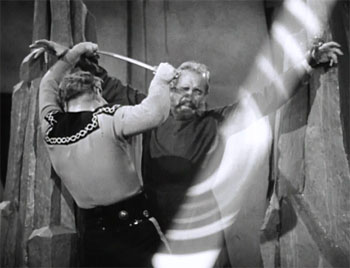
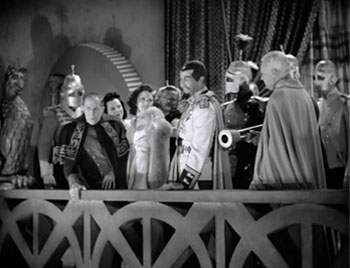
Above: The Chapter Four cliffhanger.
As you can see by the description of Chapter Four’s cliffhanger, Flash Gordon Conquers the Universe does not short-change the personalities of the Flash Gordon characters we’ve come to know and love by now, despite the accelerated pace of the action and the presence of some new actors in important roles. Indeed, Universe features some character touches from the first Flash serial that were largely absent from the second outing: Ming has once again resumed his slimy pursuit of Dale, while Zarkov has much more to do than in Trip to Mars, again assuming the co-hero function he filled in the initial serial. These echoes of the first serial might be due to the fact that George Plympton and Basil Dickey, two of the writers of the original Flash Gordon, handle the writing here–along with Barry Shipman, a newcomer to the Flash trilogy but not to serials.
Buster Crabbe once again does a sterling job as Flash, balancing the character’s superhuman heroics with good-natured affability–bursting into a hearty laugh just as quickly as he leaps into battle. Frank Shannon, as already mentioned, returns to the prominence he enjoyed in the first Flash Gordon serial, devising most of the strategies that are executed by Flash and explaining nonsensical scientific principles with convincing seriousness.
Charles Middleton is also in fine form in his final turn as Ming–scheming slyly , ranting maniacally, and uttering numerous scornful and sarcastic lines at the expense of his own men and the good guys alike. Despite the fact that this serial was filmed in the early 1940s, a decade in which the vivid, flamboyant screen villains of the silent and early sound era were rapidly vanishing before more low-key bad guys, Middleton still plays his role to the hilt, and the serial is the richer for it.
Carol Hughes, as Dale Arden, is the most successful of the new actors; though not as lovely as Jean Rogers, she’s quite attractive and very spunky and likable; she seems to fit in instantly with Crabbe and Shannon and does a fine job following in Rogers’ footsteps.
The slick, suavely dignified Roland Drew as Prince Barin is a somewhat less successful replacement; though Drew is a competent actor, he can’t make us forget the more distinctive Richard Alexander. It’s true that Barin here is not the rough-and-tumble adventurer of the previous serials, but a ruler installed in his own palace; Drew is certainly appropriate casting for this more aristocratic version of Barin , but I think Alexander had enough dignity to have pulled off the part as well. Shirley Deane, as Barin’s wife Aura, is the most jarring of the replacement players–being blonde, mild-mannered, and generally as far from Priscilla Lawson as possible. Personally, I would have cast Jeanne Kelly–who has a bit as a vixenish handmaiden here–in the Aura role instead; a heroine in the serial Riders of Death Valley and an antagonistic suspect in several of RKO’s Falcon B-mysteries, Kelly could have kept the character sympathetic while suggesting some of her old aggressiveness. That said, neither Deane nor Drew damage the serial; they just keep it from connecting completely with the earlier Flash outings.
Don Rowan, taking over the part of Officer Torch played by Earl Askam in the first serial, is a fine action heavy; while Askam’s elderly and sententious Torch seemed more like a harried middle-management official than a villain, Rowan is tough, callously mean, and very physically intimidating. Anne Gwynne, playing Ming’s female accomplice Sonja, is excellent; though she doesn’t have much to do in the first half of the serial, she gets a lot of screen time in the second half, carrying out treacherous and murderous deeds with a perpetual sneering smirk on her pretty face.
Michael Mark is very good as Karm, a scientist imprisoned by Ming who secretly aids Dr. Zarkov; he gives the character a kind of bitter dignity in the face of his continuing mistreatment by Ming. Lee Powell, hero of Republic’s The Fighting Devil Dogs and The Lone Ranger, has a nice supporting role as Barin’s aide Captain Roka, getting in on plenty of action and displaying a good rapport with Buster Crabbe. Enormous and energetic Donald Curtis, usually a villain, does a fine job as another Barin aide, Captain Ronal (if the serial had to recast Barin, Curtis might have made a more convincing replacement than Drew, since his size approaches Richard Alexander’s). Edgar Edwards, another usual villain, has a smaller role than Powell and Curtis but is also very good as another of Barin’s officers.
Earl Dwire is wonderfully demented as a scientist minion of Ming’s in the first chapter; he is so gleefully fiendish that it’s a disappointment when he’s killed off at the end of the episode. Austrian actress Luli Deste plays the haughty Queen of Frigia, and Ben Taggart is her rather pompous chief general. John Hamilton, TV’s blustery Perry White, takes over the role of Flash’s father, and is surprisingly calm and dignified. Tom Chatterton appears as Dale’s scientist father (a brand-new character), and Herbert Rawlinson is a grouchy, skeptical scientist who refuses to trust in Zarkov’s plan to save the Earth. Victor Zimmerman is Captain Torch’s sneaky lieutenant Thong, and the great character actor Byron Foulger puts in an appearance in the last two chapters as Drulk, another scientist-captive of Ming’s. Chief Yowlatchie and Mala appear briefly as (respectively) the king and prince of the aboriginal Rock People, and William Royle is Ming’s Captain of the Guards–a secret follower of Prince Barin who saves the good guys’ lives on more than one occasion. Lane Chandler, who also played bits in both previous Flash outings, appears as a Ming officer, and Roy Barcroft, his face almost always concealed behind visored helmets but his voice immediately recognizable, appears as multiple Ming soldiers and once as a Barin soldier. Eddie Parker and Tom Steele pop up in several minor roles, and also provide stunt work (Parker doubles Crabbe in the various action scenes).
Ray Taylor and Ford Beebe, who worked (respectively) on Flash Gordon and Flash Gordon’s Trip to Mars, fittingly combine here to direct the final entry in the Gordon series–an entry that, despite the criticism it’s encountered from some reviewers, deserves to rank alongside its two predecessors as one of the most entertaining and imaginative serials ever made.

Above: Dr. Zarkov, disguised as a Ming soldier, watches as the similiarly disguised Flash boards a rocket in a desperate gambit that will spell the end of Ming and the conclusion of the Flash Gordon trilogy.
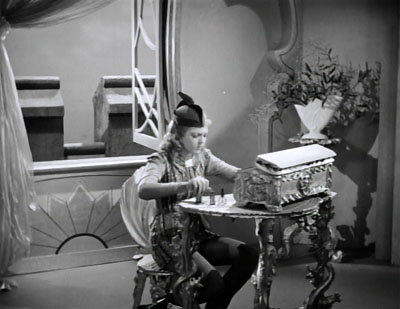
The biggest disappointment to me in this serial is the complete lack of continuity with the ending of Trip to Mars. Even granting poetic license for the recasting of key characters, how is Ming still alive after being disintegrated?
How did Barin get back to Mongo? When did Barin become ruler of Arboria? Who the hell is Ronal and how does Flash know him? After the seamless continuity between Flash Gordon and Flash Gordon’s Trip to Mars, I’ve come to expect more from the Flash serials.
Part of the reason for the continuity disconnects regarding Barin’s situation is the fact that Trip to Mars was originally supposed to be taking place in another region of Mongo (like the comic-strip continuity it was loosely based on). I don’t know why the switch in planets was made; the popular story is that Mars was inserted into the serial at the last minute in order to capitalize on the notoriety of Orson Welles’ War of the Worlds broadcast, but I’ve never seen any real evidentiary basis for that assertion. In any case, Trip to Mars‘ “Forest Kingdom,” which Barin was left to rule at the end of that serial, was, in the comic strips, simply another name for Arboria on Mongo. Thus, had the planet in Trip to Mars been Mongo instead of Mars, two continuity issues (Barin’s return to Mongo and his rule over Arboria) would have been eliminated.
As for Ronal, he had become a regular character in the comic strip, and here Universal was simply playing “catch-up”–introducing him and pretending he’d been there all along. If you wanted to play the same type of game that Star Trek fans play with their continuity (Khan met Chekov off-camera during the events of “Space Seed”), you could pretend that Ronal was a member of Barin’s anti-Ming resistance group who was operating elsewhere (perhaps acting as a liaison to the Lion Men?) during the first serial, and that Flash and company met him during an off-camera celebration following the fall of Ming but preceding their return to Earth.
The reintegration of Ming is hard to explain away, however; we don’t see his remains, but Flash’s expression at the climax of Trip to Mars makes it clear he’s supposed to be looking at mounds of crumbled Ming-matter. If it wasn’t for that, I’d just assume that Ming had a secret exit from the disintegration chamber and that he left his robe and cape behind to make the Earthmen think he’d been eradicated.
Of course, the main reason that Conquers the Universe doesn’t mesh neatly with its two predecessors is that it was an unplanned sequel; Universal never intended to make a third Flash Gordon outing; instead, a sequel to Buck Rogers was planned for the studio’s 1940 production slate (“Killer Kane” was left very much alive at the end of that outing, which would have made a sequel quite easy to set up). Buck did so poorly, however, that the studio decided to return to the more tried-and-true Gordon characters, even though that entailed (1) drastically revising the look of the serial to match the drastically altered visuals of the comic strip, (2) bringing in new actors to replace key players who were either signed at other studios (Jean Rogers), had given up acting (Priscilla Lawson), or didn’t look like the comics characters any more (Richard Alexander), and (3) glossing over some continuity issues.
This was the first Flash Gordon serial that I saw in my youth. For a time, if pressed, this school boy critic would have considered “Conquers the Universe” the best of the trilogy, As you review points out, it’s briskly paced, technically polished, and, on a movie serial budget, wonderfully matches the illustrative style of artist Alex Raymond. The new supporting cast didn’t deter my enjoyment because we still had the star players- Buster Crabbe and Charles Middletown! However, today I agreee with some of the criticism. At times seems more a chaste, 1940’s remake of the original “Flash Gordon.” There’s also a repetiveness to it: How many times do Flash and his cohorts break in and escape from Ming’s castle? I rank it 3 out of the 3. But yeah, it’s still a darn good entry at the height of the genre’s golden age.
This is an interesting site and very informative. I love all three of the Gordon serials, but did have my own questions regarding the third installment. Those questions have now, thankfully, been answered – except, of course, Ming’s reincarnation. Like many Flash lovers I have the complete DVD set of all three serials and recently have acquired the Rocket Ship kit sold by Fantastic Plastics. – something I have been seeking for many years. I hope to complete construction in the coming weeks and create a Diorama for which I will have to find a suitable place of honor within our household for Zarkov’s plucky little creation able to speed through millions of miles of interplanetary space powered only with July 4th sparklers! Wonderful Stuff!
One more thing. Perhaps the costuming was a reaction to “The Prisoner of Zenda”, 1937 followed by “The Adventures of Robin Hood”, 1938! Makes sense to me that a serial like Conquers the Universe would try to capitalize on the popularity of those films.
The absence of lovely Jean Rogers as Dale is a disappointment but Hughes does a very good job (and a lot less screaming) The sets are spectacular the action plentiful Sadly real world conflicts replaced the imaginary ones from Mongo and this was the last Flash serial
Action filled….Worth Watching…While watching this serial I thought that the Studio used every costume from their clothing Dept. Many outfits look like they are from Medieval Movies and other types of movies…
Excellent review. I have always felt that this installment has been unfairly slammed by many critics. Perhaps it’s not at the same level as the first two, but it’s quite enjoyable on its own merits. Great cast, great action and many interesting twists in the story.
The ending has puzzled me for a long time. It almost seems that the film makers were leaving the door open to a followup, given Zarkov’s comment about Ming and a possible escape.
when anne Gwynne appeared as lady Sonja she was simultaneously filming a part in another movie which explains her absence from parts of the serial (jean rogers did the same thing during TRIP TO MARS). Gwynne was absent during the rock people location shoot; a double was used there and closeups of her were later inserted.. this serial is my favorite partly due to liszt’s LES PRELUDES music being used extensively.
This is probably my favorite serial. Love everything about it. And as you mentioned Dan the ending to chapter four is one of the most believably emotional cliffhangers ever. One thing has always bugged me though – in chapter one about 4 1/2 minutes in Torch has discovered Flash’s ship, and Dale, looking through her scope notices and says “Careful Flash they’re turning for an attack” and then a different voice (Goodkind I think) is overdubbed and says in a non Buster accent: “Throw it in revoise”. Why that line? Revoise? A rocket ship?
I also think Zarkov’s line “Your destruction of our people has gone far enough!” with Liszt in the background hits like a sledgehammer. What a terrific serial.
Thank you for this splendid review of this wonderful serial, of course one of my all time favorites. You very nicely handled the issue of grumpiness on the part of earlier commentators who have dismissed this serial as the “least of the 3”. Im just not seeing this entry as a “least” serial in any way. Thankfully it appears that Fate is reviewing UNIVERSE much more favorably now. The switch in personalities re Aura is a puzzle, though bits and pieces of commentary have suggested that The Top wanted things toned down, the sexuality, the presence of so many “half human beast men” (Filmation animation head in a DVD commentary said that this was to appease the heartland over various issues like evolution but I have no proof to offer here), for example. I went over my Sunday Alex Raymond compilations and the move to switch Aura from a lusty Mediterranean woman of “hot blood” over to a chaste, prim Nordic princess can be found in the newspapers just before this serial went before the cameras. It really is TWO very different Auras. As you likely know, the 1980 movie gave us back that sultry, sexy Princess we’ve come to admire.